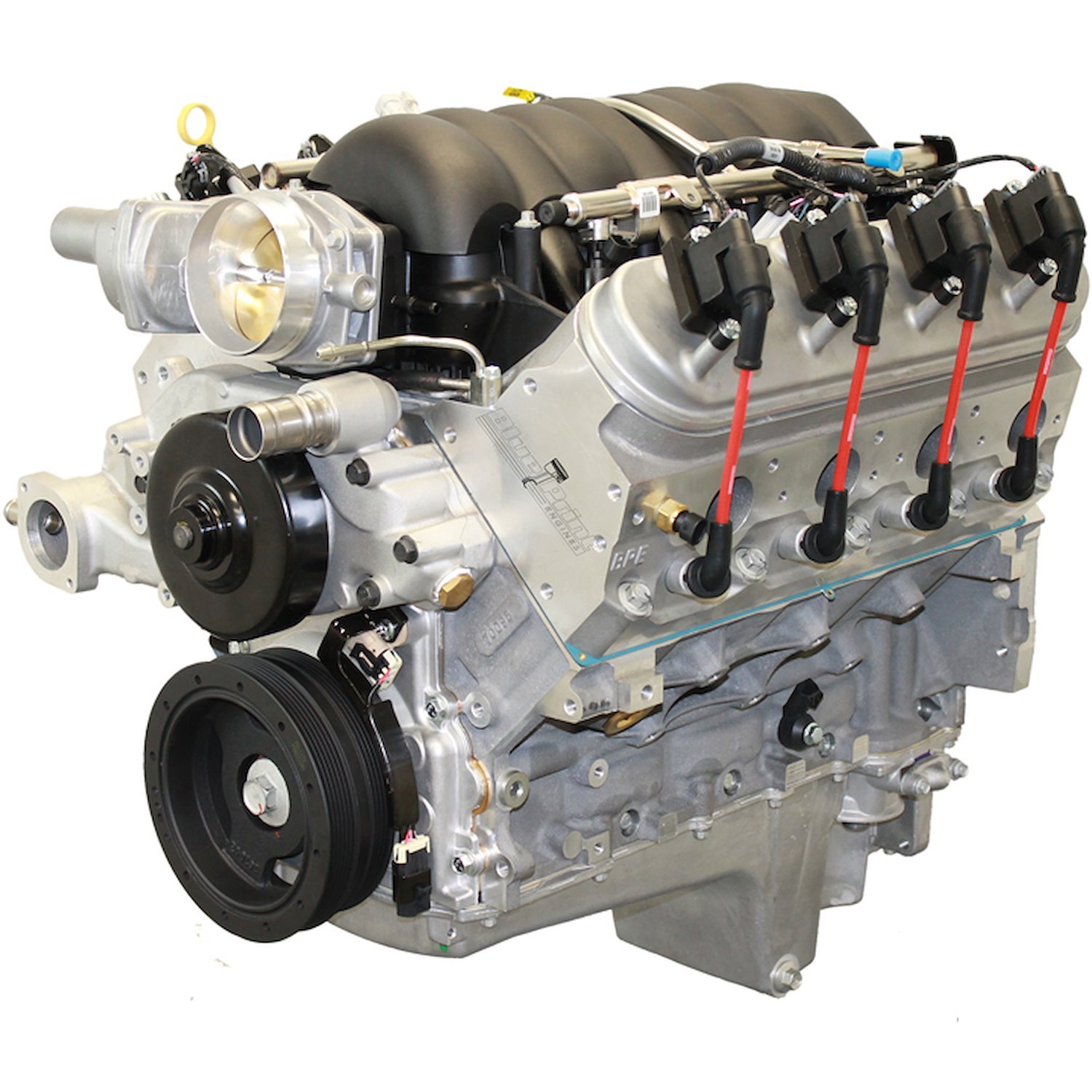Items You Need
Dress Engine
- Not designed for late model applications that were originally equipped with factory fuel injection
- Not for EGR
Recommended Stall Converter: 2200+ RPM
Recommended Fuel: 91-93 Octane
- New GM 6.2L aluminum block
Rotating Assembly
- Nodular Iron Crankshaft: 3.622 in. Stroke
- Forged Connecting Rods: 6.098 in.
- Hypereutectic Pistons
- 10.7:1 Compression
- Internally Balanced (Balancer Included)
Cylinder Heads
- LS3 Aluminum
- Combustion Chamber: 68 cc
- Intake Valve: 2.165 in.
- Exhaust Valve: 1.600 in.
Camshaft Specs
- Hydraulic Roller
- Duration at .050 in. Lift: 225 Intake, 238 Exhaust
- Lift: .612 in. Intake, .585 in. Exhaust
- Lobe Separation: 113 Degrees
Other Features
- GM LS3 Intake Manifold, fuel rails, injectors
- Drive By Wire throttle body
- GM Hot Rod universal oil pan
- AC Delco coil packs and plug wires
- Firing Order: 1-8-7-2-6-5-4-3
- ACDelco 41-985 spark plugs (.040 in. Gap)
- Includes coil packs, coil wiring harness, crank, cam, coolant, knock, oil pressure, and map sensors
Engine Break-In Procedure
Use or break-in oil or conventional (non-synthetic) multi-viscosity oil with zinc additive for the first 500 miles of operation. Avoid hard acceleration for sustained periods. Periodically change the engine speed while driving to help seat the rings. While the engine is running, be sure to check oil pressure and coolant temperature, and check for fluid leaks, such as oil, transmission fluid, fuel, and coolant/antifreeze. Also listen for any unusual sounds. Should you hear an unusual sound, shut the engine off, check for the source, and correct it.
Engines with flat tappet cams only - Start the engine and bring it to 2,000 RPM. Get the engine running smoothly. Then vary the engine speed from 1,800-2,200 RPM in a slow acceleration/deceleration cycle for 30 minutes. This is necessary to provide adequate oil splash and lifter rotation to properly mate each lifter to its lobe.
At 500 Miles change the engine oil and filter using conventional (non-synthetic) oil. After 6,000 miles, synthetic oils can be used in your engine. For flat tappet cam engines, continued use of oil with zinc or a zinc additive for the life of your engine is recommended.
Specifications:
Would this fit in a 2012 Cadillac Escalade platinum it has a 6.2L Engine. Can I swap for this LS3 Engine?
Will it fit in a 2007 Chevy Silverado
Will this fit in 69 Camaro and can I get one any sooner?
Will this fit in a 97 Silverado pick up
Will this fit in a 79 vette
Will this work in a 1996 Trans Am. Will I need the the peddle or computer?
What do need to put this engine in my 98 corvette?
Will this fit in my 2000 GMC Sierra what's the changes
Motor Vehicles
WARNING: Motor vehicles contain fuel, oils and fluids, battery posts, terminals and related accessories which contain lead and lead compounds and other chemicals known to the State of California to cause cancer, birth defects and other reproductive harm. These chemicals are found in vehicles, vehicle parts and accessories, both new and as replacements. When being serviced, these vehicles generate used oil, waste fluids, grease, fumes and particulates, all known to the State of California to cause cancer, birth defects, and reproductive harm.
Tools:
WARNING: Some dust created by power sanding, sawing, grinding, drilling, and other construction activities contains chemicals known to the State of California to cause cancer and birth defects or other reproductive harm. Some examples of these chemicals are: lead from lead-based paints, crystalline silica from bricks and cement and other masonry products, and arsenic and chromium from chemically treated lumber. Your risk from exposure to these chemicals varies, depending on how often you do this type of work. To reduce your exposure, work in a well-ventilated area and with approved safety equipment, such as dust masks that are specially designed to filter out microscopic particles.
Electrical Cords
WARNING: The wires of these products contain chemicals known to the State of California to cause cancer and birth defects or other reproductive harm. Wash hands after handling.

